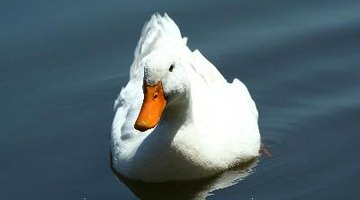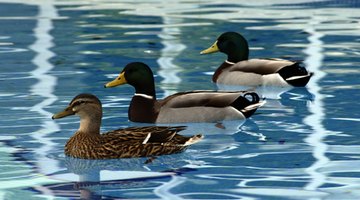How Big Does a Pond Have to Be for Ducks?
According to the Maine Department of Fisheries and Wildlife, about 150 species of ducks are found throughout the world. Whether wild or domestic, all ducks have one thing in common: They love and need water to survive.

From rivers to lakes, oceans to swamps, ducks depend on different bodies of water for food, nesting sites and safety. Natural and man-made ponds are also popular havens for ducks. The size of the pond will largely be determined by the needs and number of ducks.
Ducks and Water

Ducks are waterfowl, perfectly adapted to the aquatic life. Webbed feet, waterproof feathers and the ability to dive serve them well in their watery worlds. Ducks need water deep enough to submerge their heads, as they must flush their nostrils while eating and regularly rinse their eyes. Some duck species must have deep water to mate. Ducks do not require water for bathing, but it will aid them in preening their feathers and they most certainly enjoy it. Few creatures are happier than a duck in water.
Pond Uses
The size of a duck pond should be based on its intended uses. Wild ducks will cover a body of water while migrating but prefer isolation when breeding. Domestic ducks raised in a farmyard can be kept at a higher density throughout the year if the water is kept clean.
Artificial Pond Size

Suitable man-made ponds come in a wide variety, from large excavated water holes to simple plastic kiddie pools. The "International Journal of Laboratory Animal Science and Welfare" recommends that ducks kept in captivity be provided with 6 to 9 square feet of pond area per bird. Container ponds that do not have a filter or vegetation should be emptied and refilled daily to prevent the water from becoming filthy.
Wildlife Pond Size
A pond intended to attract wild ducks and harbor other wildlife should be relatively shallow (up to 4 feet deep) and be shaped to maximize the amount of edge. Plants that provide food and cover include cattails, bulrushes and pondweed. "Managing Michigan Wildlife: A Landowners Guide" advises that ponds should be at least 60 feet wide to reduce the risk of predation on ducks. To support a single duck family (an adult pair and their ducklings), a pond needs to be at least one acre in size.
References
Writer Bio
Amy Schauland has been writing professionally about organic gardening for eHow Home & Garden since 2010. She caught the writing/editing bug in a high school creative writing class in 1998. Amy graduated from University of Wisconsin-Stevens Point with a bachelor's degree in psychology.
Photo Credits
- White domestic duck in a pond image by Jim Mills from Fotolia.com
- White domestic duck in a pond image by Jim Mills from Fotolia.com
- patos image by juanjo tugores from Fotolia.com
- duck image by saied shahinkiya from Fotolia.com
More Articles



